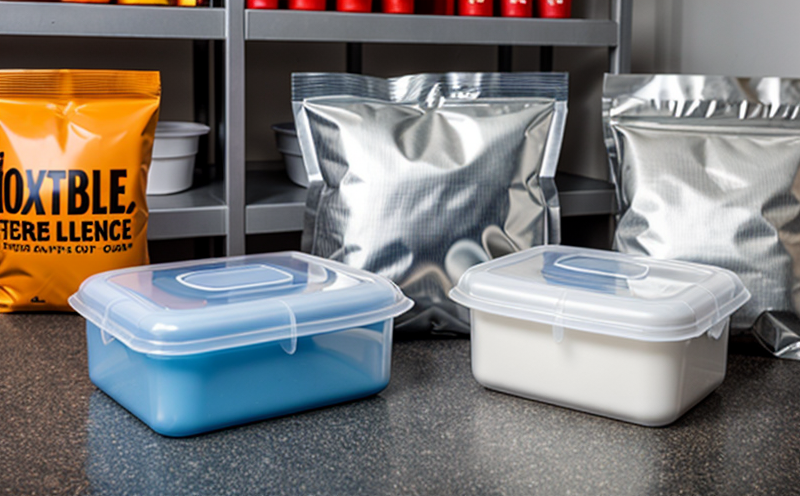ASTM D3895 Oxygen Barrier Testing
The ASTM D3895 standard is a crucial method used to measure oxygen permeability in flexible packaging materials. This test helps ensure that the packaging effectively prevents the ingress of oxygen, which can lead to spoilage or degradation of the product inside. The primary application for this testing lies in food packaging, pharmaceuticals, and other products with sensitive contents.
The ASTM D3895 procedure involves placing a sample of the flexible material between two chambers separated by an impermeable barrier. One chamber is filled with nitrogen while the other contains pure oxygen. The permeability of the sample is determined by measuring the rate at which oxygen passes through it into the nitrogen-filled chamber over time.
The test setup typically includes specialized equipment such as gas manifolds, temperature and humidity control systems, and data acquisition software to ensure accurate measurements. Compliance with international standards like ISO 15106-2 also ensures that results are comparable across different laboratories worldwide.
Understanding the permeability of oxygen through packaging is critical for several reasons. For instance, excessive oxygen can cause fats and oils in food products to become rancid faster than intended. In pharmaceuticals, incorrect oxygen levels could alter drug stability or affect shelf life significantly. Therefore, accurate and reliable testing methods like ASTM D3895 play a vital role in maintaining product quality throughout its lifecycle.
The ASTM D3895 procedure is applicable to various types of flexible packaging materials including films, foils, laminates, and coatings applied to these substrates. It provides detailed instructions on specimen preparation, chamber configurations, measurement techniques, and calculation methods to obtain meaningful results.
Specimen preparation involves cutting the sample into specific dimensions dictated by the test method. These cutouts are then mounted between the two chambers as described earlier. Temperature and humidity conditions during testing can also influence oxygen permeability; hence controlled environments are essential for obtaining accurate readings.
In summary, ASTM D3895 Oxygen Barrier Testing is indispensable for manufacturers who need to ensure their flexible packaging products meet strict quality standards regarding oxygen barrier performance. By adhering strictly to this standard and using appropriate equipment, companies can produce reliable results that help maintain product integrity and extend shelf life effectively.
Benefits
- Enhanced Product Quality: Ensures that the packaging maintains optimal conditions for the contained products, thereby extending their shelf life.
- Improved Consumer Satisfaction: By preventing spoilage and maintaining freshness, consumers are more likely to be satisfied with your product offerings.
- Avoidance of Regulatory Penalties: Compliance with international standards helps avoid potential legal issues associated with non-compliance.
- Increased Market Competitiveness: Superior packaging performance can set a brand apart from competitors, leading to higher market share and customer loyalty.
Quality and Reliability Assurance
Oxygen barrier testing is critical for maintaining the quality of packaged goods. It ensures that packaging materials do not allow excessive amounts of oxygen to pass through, which could otherwise degrade sensitive products like food items or medications.
- Accurate Measurement: Using precise instruments and adhering strictly to ASTM D3895 guidelines guarantees accurate measurements of the permeability rate.
- Consistent Results: Standardized procedures ensure consistent results across multiple tests, enhancing reliability.
- International Compliance: Meeting international standards like ISO 15106-2 ensures compatibility and acceptance in global markets.
By implementing rigorous quality control measures during the testing process, laboratories can provide clients with confidence that their packaging solutions meet required specifications. This is particularly important for industries where product integrity and safety are paramount concerns.
Competitive Advantage and Market Impact
In today’s competitive marketplace, having superior packaging can be the deciding factor between success or failure. By offering ASTM D3895 compliant oxygen barrier testing services, laboratories help clients achieve several key advantages:
- Better Product Performance: Ensuring that your product remains fresh and safe for longer periods improves customer satisfaction and loyalty.
- Innovation Leadership: Demonstrating expertise in advanced testing methods positions you as a leader in innovation within the industry.
- Increased Sales: Superior packaging can lead to increased sales by appealing to consumers’ desire for quality products.
The ability to consistently deliver high-quality results through ASTM D3895 testing can significantly enhance your brand’s reputation and market position. It demonstrates a commitment to excellence that resonates well with discerning customers.





